Guest Article, Photos and Illustrations courtesy of Gene Gade
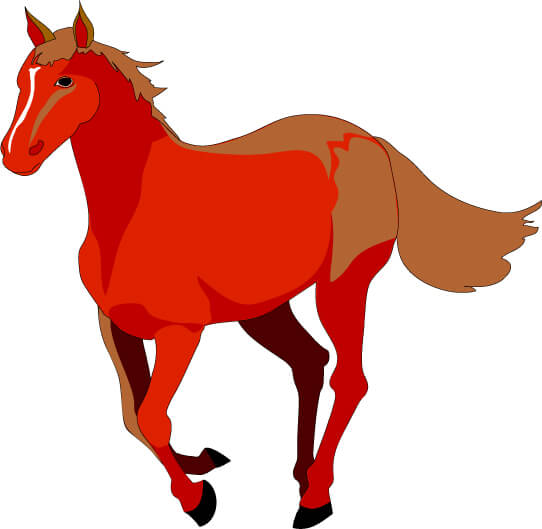
Introduction of horses into the cultures of bison-hunting Plains Indians caused changes at least as rapid and profound as did the introduction of automobiles and trucks into early 20th Century America.
How incredible it must have been to people who had hunted for millennia on foot.
Entire paradigms of travel speed, distance, load-carrying capacity, communication, trade and warfare were transformed within a very short time. Now Indians could hunt year-round from horseback. Hunters could range much farther from camp to find their quarry.
A skilled rider with a good mount could now run with the bison and pick individual animals to kill. They could load the meat and hides onto much larger and stronger animals for the journey home.
They didn’t have to feed any of the meat to their beasts of burden as they had for the thousands of years when dogs served that role.
As the numbers of available horses increased, tribes were less dependent on communal hunts in the fall. Within a generation or so of the arrival of horses, “buffalo jumps,” including the Vore site, essentially became obsolete.
As usual, archaeology at the Vore Buffalo Jump provides inferential evidence about this major cultural shift. In all of the early, deeper cultural levels at the VBJ, the buffalo carcasses were broken down into relatively small pieces of meat and bone.
Presumably this pattern was necessary because a human being (possibly an adolescent) had to manually lug them out of the sinkhole and transport them on a dog-propelled travois to a processing camp that may have been several miles away.
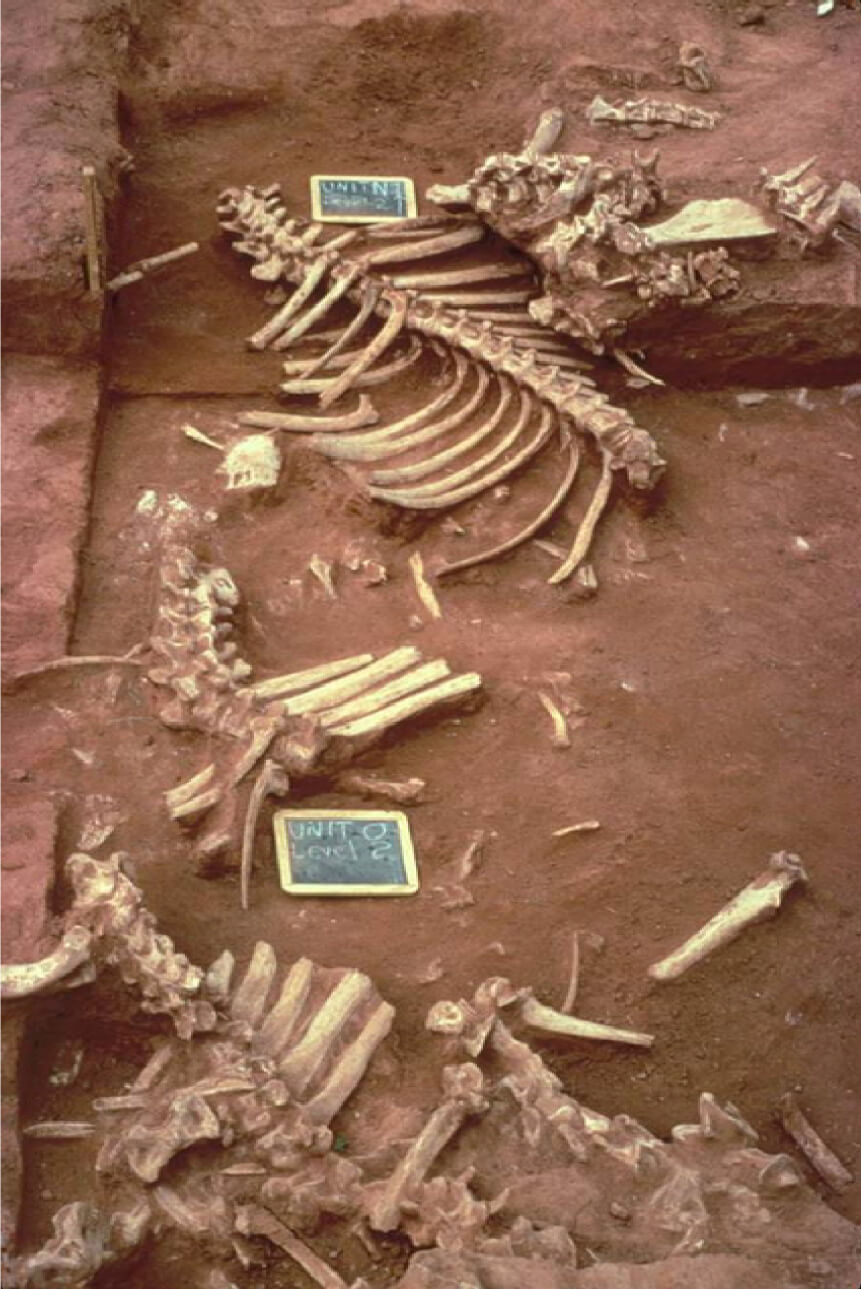
The butchering pattern changed for the last times the Vore site was used. These parts were too big to be carried out of the sinkhole by an individual human of any age, gender or stature. These carcasses near the top of the dig were broken into much larger segments than lower bones. This indicated the arrival of a larger beast of burden—the horse. All photos furnished by author, Gene Gabe.
The butchering pattern changed in the last couple of times the Vore site was used. Basically, these carcasses were broken into much larger segments, too big to be carried out of the sinkhole by an individual human of any age, gender or stature.
Almost certainly this change was made possible by the arrival of a larger beast of burden—namely the horse. The archaeological record at the Vore site indicates that this dog-to-horse transition happened in the late1780’s or 1790’s .
Presumably during the early stages of transition, any given tribe would have had few horses and they would probably have been in the hands of high-status males.
As more horses became available, more of them would have been used for important, but relatively mundane tasks like dragging quarters of bison carcasses out of a sinkhole and carrying them to camp.
By about 1800, activity at the Vore site stopped fairly abruptly. Possibly because, by then, the regional tribes had enough horses so they could hunt for fresh meat in all seasons and no longer needed to acquire massive amounts in autumn communal hunts using buffalo jumps.
Origin of Horses
Horse-like animals appeared in the fossil record over 50 million years ago. After separating from their relatives, rhinos and tapirs, during the Eocene Epoch, the horse family tree radiated into a number of forms, most of which became extinct leaving no ancestors.
Originally a forest animal less than 20” tall, horses had four toes on their front legs and three toes on their hind appendages and teeth adapted to browsing woody plants.
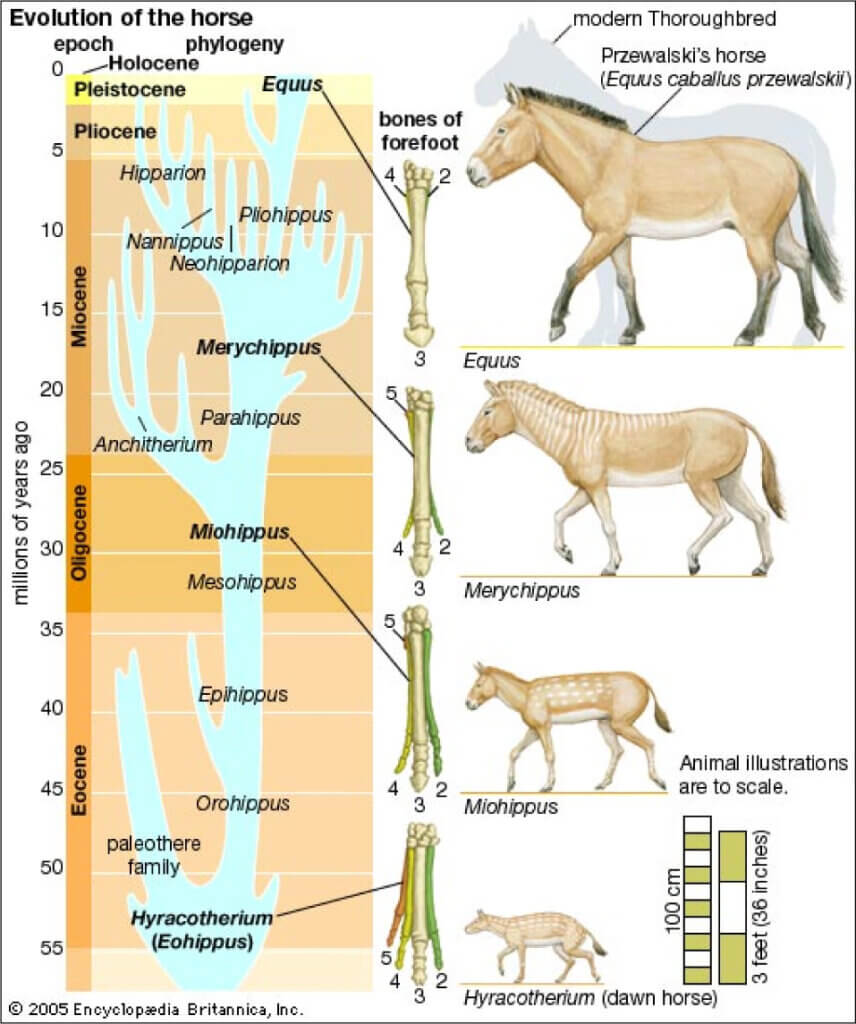
Earliest horses (Eohippus) at the bottom of chart were less than 20” tall, with four toes on their front legs and three toes on their hind legs. That was 55 million years ago. By modern times, the Equus horse in addition to being much larger had gained four single-toed hooves.
The climate of North America became drier during the Oligocene Epoch. Forests shrunk and grasses became more abundant. Horses adapted by becoming larger and faster and by becoming more of an open country animal.
By the Miocene, about 24 million years ago, large grasslands had appeared. One of the three main branches of the horse family expanded into this new niche and, over time and with many failed experiments, became the large, fast, single-toed, grass eater that we know as Equus, the modern horse.
During their development, horses successfully spread to Eurasia. Ironically, they became extinct in their continent of origin—North America–during the late-Pleistocene only 10 to 20 thousand years ago.
Some people believe that, along with rapid and major climate change at the end of the Ice Ages, horses and some other by species were extremely stressed and that hunting by the newly arrived human population tipped a number of Pleistocene mammals over the edge and into extinction here in North America.
A Legacy of the Conquistadors
There are legends that the horses that Plains Indians acquired were descendants of half a dozen feral animals that escaped from the would-be Conquistador, Coranado.
Following the example of Cortez and the Aztecs and Pizarro and the Incas, Coranado went all the way to Kansas in 1540 looking for another rich Indian culture to pillage and plunder.
There are also stories about horses escaping from a Spanish ship that wrecked on the coast of Texas.
It’s possible that a very few horses escaped in such a fashion, but they did not propagate the hundreds of thousands of horses that ended up with the Plains tribes.
The Spaniards were indeed the folks who brought horses north from Mexico to their missions and settlements near Santa Fe and in California.
However, they understood how much of an advantage horses provided and they tried very hard not let their horses fall into Indian hands. In fact, it was illegal under their rule for Indians to ride or own horses.
However, some Indians who were slaves on Spanish Rancheros learned to handle the speedy and powerful new animals.
Comes the Revolution
The event that changed the entire situation was the Pueblo Rebellion of 1680. Having chaffed under the heavy hand of the Spanish for over a century, the normally peaceful farming villages along the Rio Grande River and its tributaries, rose up and violently chased the Spanish back to Mexico.
As the Spaniards retreated in disarray, much of their livestock, including many horses, were captured by regional Indian tribes. The Pueblos apparently did not keep the Spanish animals, but some of their more nomadic neighbors, especially the Utes and Comanches took as many horses as they could catch, capture or trade for.
When the Spaniards returned a dozen years later, the Comanches on the Plains and the Utes in the Mountains were committed horse people. Moreover, those tribes had relatives and trade partners.
The genie was out of the bottle. The cultural revolution was on.
The Spanish colonial horses that the Indians acquired were derived from several European breeds including Spanish Barbs, Arabians and Lipizzaners. They came in a wide variety of color, size and conformation.
The average Indian horse was small in stature, but strong and wiry. They probably stood only 13.2 to 14 hands high and they probably weighed about 700 pounds on average. (By comparison, modern quarter horses are usually 15 to 17 hands high and weigh over 1,000 pounds.)
Indian horses are described as having a “large head with a good eye; short thick neck; large round barrel; relatively heavy shoulder and hip; fine limbs and small feet.”
By trading (and probably raiding) horses were transferred from tribe to tribe. The transfer occurred on both sides of the Rocky Mountain chain.
The Utes apparently took horses across the mountains and into the Great Basin. The Comanches and their trading partners took them north via the Plains, east of the Rockies.
The Shoshone Connection
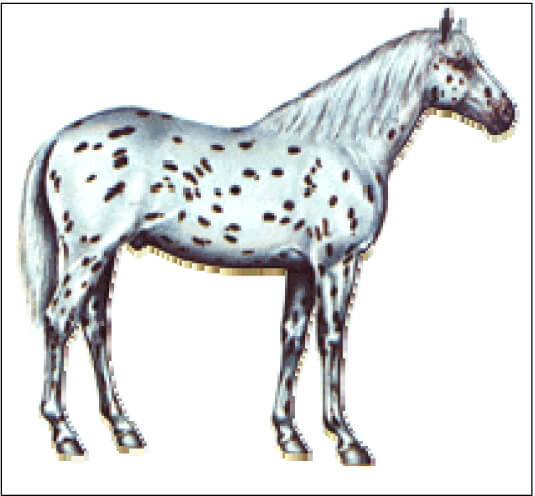
The Nez Perce became famous for their spotted Appaloosa horses, a name that came from the Palouse region where they lived.
Both the Utes and the Comanches were relatives of the Shoshone, so the Shoshone were among the first of the more northern tribes to acquire horses.
For a generation or so in the middle 1700’s, the Shoshone gained power and expanded their territory to include large areas of the buffalo country. During this period and, perhaps later, they probably used the Vore Buffalo Jump.
Most of the Great Basin groups were linguistically and culturally Shoshonean. Horses kept moving with them through the Basin to the Palouse Prairie in what is now eastern Oregon, Washington and Idaho where they were acquired by the Nez Perce.
The Nez Perce became famous for developing a distinctive breed of spotted horses—the Appaloosa—a somewhat distorted name for the Palouse region where they lived.
The trade continued north and east from there, bringing horses to the Flathead, Blackfeet and Cree Indians over the next 20 to 30 years.
Written history from the fur-trapping War Chief—A Nakota horse thought to have conformation typical of Indian horses from the pre-reservation period documents that the Blackfeet had few horses during the early decades of the1800’s.
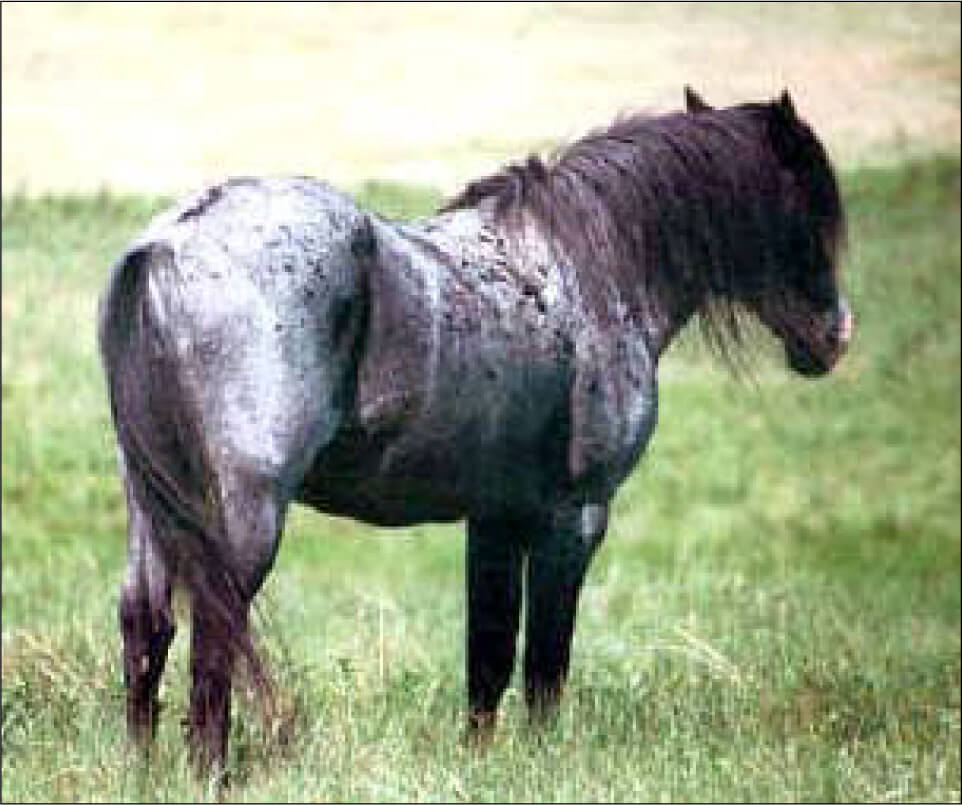
War Chief—A Nakota horse thought to have conformation typical of Indian horses from the pre-reservation period.
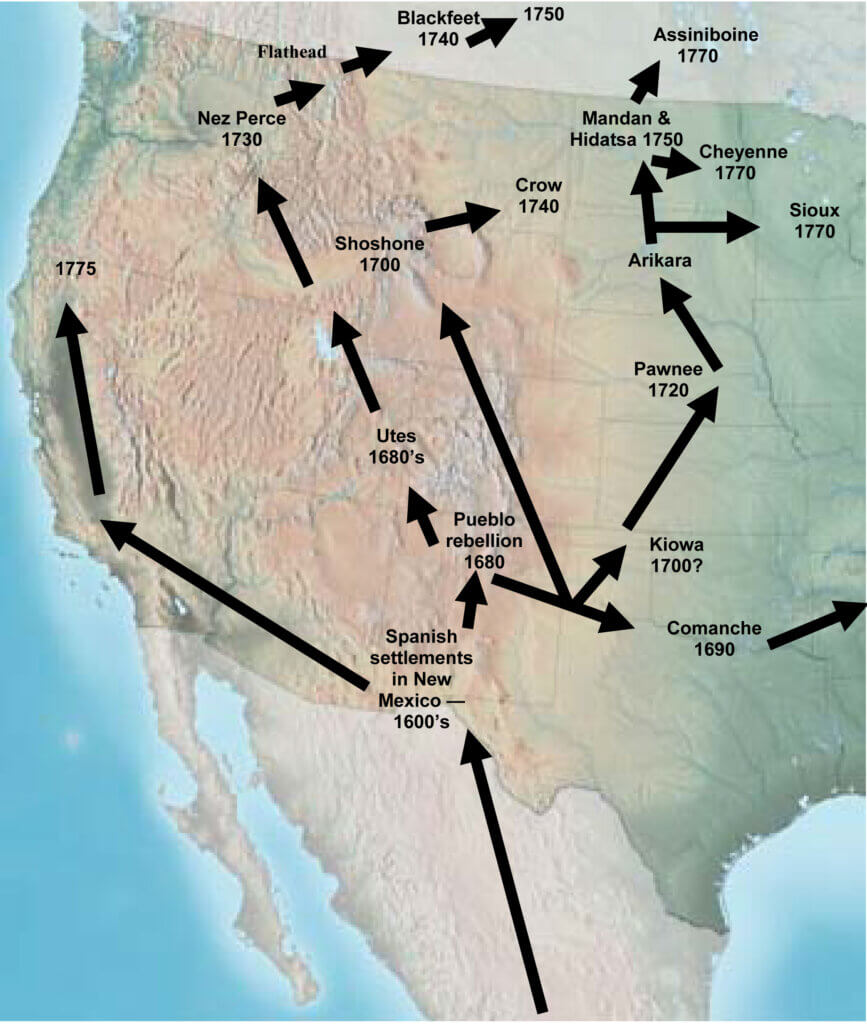
Horses moved north from Spanish settlements in New Mexico in the 1600s. A few horses reached the Comanche in 1690, Shoshones in 1700, Pawnee in 1720 and the Nez Perce by 1730, first with small numbers.
Postulated Pattern and Time-line for Distribution of Horses Among Indian Tribes in the Western United States
Spanish colonialists brought numerous horses to rancheros and missions in New Mexico and California in the 1600’s.
The Pueblo Rebellion of 1682 allowed regional Indian tribes to capture horses abandoned by the Spanish.
The were two major dispersal paths: from the Utes through the Rockies and Great Basin and from the Comanche northward and eastward from the southern Great Plains, but mostly east of the Rockies.
It took over half a century for trade and warfare to disperse horses from the southern to northern Plains, but horses created a cultural revolution everywhere they went.
Dispersion to the Northern Plains
The Crow or Absoraka tribe are often cited as among the first and best horsemen of the northern Plains. However, they probably acquired horses from the Shoshone about 1740. Being relatives of the Hidatsa, they probably also exchanged horses and other trade items with them as well.
The main branch of the Plains trade route was north from the Comanche in Texas and Oklahoma.
Around 1720, the Pawnees acquired horses. The Pawnee along with most of the Missouri River Indians made their living partly with farming (corn, beans, squash, etc) and the rest with hunting (bison) and trading.
They lived most of the year in earthlodge villages along river valleys. They were centrally located with a cultural center in eastern Nebraska and from there were also important in trade and warfare both up the Missouri River to the north and west along the Platte River.
The Arikara [or Rees], who lived farther up the Missouri, were closely related to the Pawnees and were also integral to regional trade.
The Arikara almost certainly got horses from the Pawnee sometime in the middle of the 1700’s. They, in turn, would have traded with the other earthlodge-dwelling/farming-hunting cultures farther up the river—the Mandan and Hidatsa.
Linguistically and culturally, the Mandan and Hidatsa are similar (Siouan language) and they were renowned in their day as entrepreneurs.
Until they were decimated by smallpox, the Mandan and Hidatsa were at the hub of tribal trade in the northern Plains. They traded farm goods (corn, etc.) for the meat and hides brought by the bison hunters.
As European goods started to arrive via the river and lake transportation routes of southern Canada and as the fur trapping enterprise expanded, the Mandans and Hidatsa were central in that trade as well.
It is likely that, when horses arrived, the Mandan and Hidatsa were central to their dispersal to regional tribes including the Cheyenne, Sioux and Assiniboine.
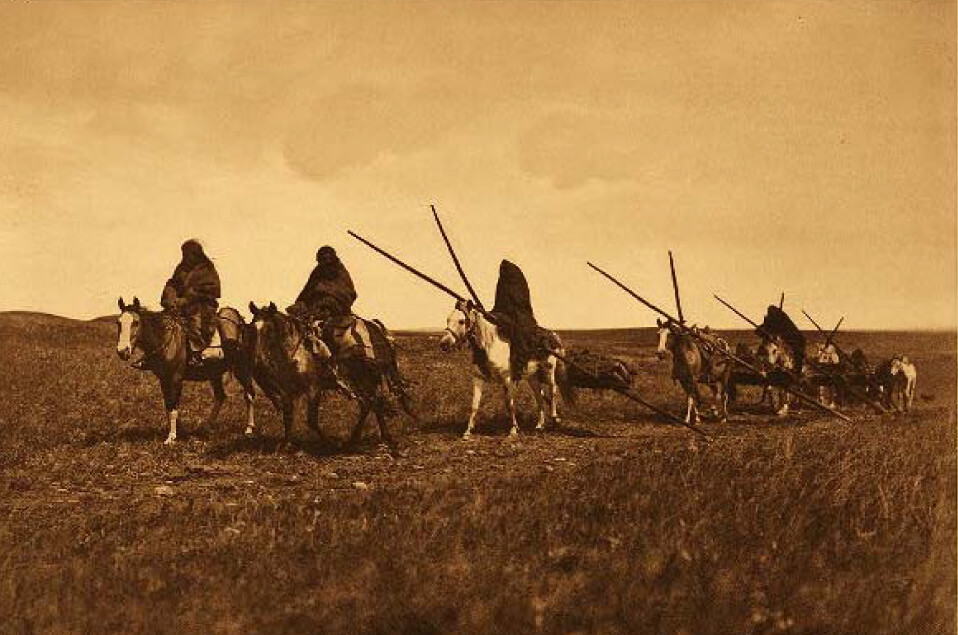
Blackfoot people on the move.
Once horses were available, the switch to the nomadic lifestyle of following the buffalo herds was swift and complete for the Cheyenne and Sioux.
By the time most of the Anglo-American journals were written, just a few decades later, the Cheyenne and Lakota were the consummate and most powerful buffalo hunting/tipi dwelling/horse riding Indians on the northern Plains.
Only the oldest tribesmen could really remember life without horses by then.
For Caucasians moving west, it was an easy assumption that the tribes had possessed horses and practiced their 1800’s culture for a very long time.
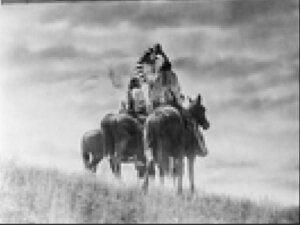
Edward Curtis photo of horse-mounted Cheyenne Warriors–1905
Good buffalo runners and war ponies were among the most prized possessions of 19th Century Plains hunters and warriors. The relationship between Indians and horses seemed inextricable.
For most northern Plains tribes, the era of free-roaming, horse-mounted buffalo hunters lasted little more than a century, but it was, for them, a glorious period indeed!
Guest Article by Gene Gade. As the County Extension Agent in Sundance Wyoming, Gene Gade served 20 years as president of the non-profit Vore Buffalo Jump Foundation, helping to develop and guide the research, education and economic potentials of the Vore Buffalo Jump site until his retirement. He has continued to write for the VBJF Newsletter. Reprinted from the VBJF Newsletter with permission: Vore Buffalo Jump Foundation, 369 Old US 14, Sundance WY 82729; Tel: (307) 266-9530, email: <info@vorebuffalojump.org>
————————–
NEXT:
__________________

Francie M Berg
Author of the Buffalo Tales &Trails blog



FACINATING.
great information and history Francie. The horse lovers out there will be interested in this. Does the NBA and CBA help you distribute your blog or have they ever asked to include some in their magazines. especially if they had room these would be a good read for many bison producers on both sides of the border.
Well done! Very good article!
Great article. Thanks for sharing all this great historical information!
I enjoyed the horse article very much! Thanks
I came upon your article by chance. It is the best explanation I have read – I was working as a guide for an archaeological site in Arizona, and found it was difficult for people to grasp that there were no horses or other “beasts of burden” available to ancestral puebloans, and what an impact their arrival made on their lives. Thank you
Thank you for the wonderful history of the arrival of the horse to the northern plain Indians. I give a little history lecture to guests at a dude ranch in northern Wyoming and try to describe the history of the horse culture in this area. The article was very helpful to me. Best to you. Pat McCune
Excellent article!!!